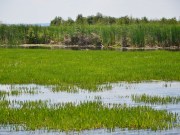
OTTAWA — Canada’s chief public health doctor says Canadians in communities where COVID-19 is still spreading should wear non-medical masks when they can’t stay physically distant from others.
Dr. Theresa Tam is also urging Canadians not to forget how hard this pandemic has hit vulnerable seniors in long-term care homes and the need to ensure that the standards of care in seniors’ residences are improved.
While Tam said almost half the people confirmed to have COVID-19 in Canada have now recovered, and most provinces reported either no or very few new cases Wednesday, Ontario and Quebec are still seeing hundreds of new COVID-19 patients every day. Long-term care centres account for a large number of them. Nationally, one-fifth of all cases, and more than four-fifths of all deaths from COVID-19, are connected to long-term care, with outbreaks in hundreds of facilities.
Ontario, where outbreaks of COVID-19 have hit 40 per cent of the long-term care homes, became the latest province to take steps to control management of privately run long-term care homes Wednesday, enacting an emergency order to give itself that power. Premier Doug Ford said it will mean Ontario is better prepared to “immediately swing into action if a home is struggling to contain this deadly virus.”
Quebec, Alberta and British Columbia have all stepped in to take over management of some privately run homes after outbreaks got out of control.
Tam said there are many lessons to be learned from this “tragic characteristic” of the pandemic in Canada, and said we can’t “let these lessons be forgotten.”
“I think improving all those standards and conditions for our seniors is very important,” she said.
But during a House of Commons health committee virtual meeting Wednesday, several advocates for seniors were blistering in their criticism of governments’ management of long-term care. Paul Brunet, the president of the Conseil pour la protection des malades in Quebec, said Canada and Quebec both ignored warnings issued by the World Health Organization in February and March about the risks COVID-19 was posing to vulnerable seniors living in care homes.
Jodi Hall, the chair of the Canadian Association for Long Term Care, said hundreds of facilities in Canada simply cannot do what the public health recommendations say — namely isolate residents from each other — because they have only three- and four-bed rooms, narrow hallways and one dining room.
Hall said the government needs to make some infrastructure money available to immediately upgrade the more than 400 homes in Canada in that category.
All provinces are turning their attention to reopening their economies, with several already into the first phases. Ontario and Alberta are set to announce reopening plans Thursday.
Prime Minister Justin Trudeau urged Canadians to remain careful as things gradually reopen: staying home as much as possible and staying distant from others when they do have to go out.
“I know we’re all looking forward to it but we have to be vigilant,” he said in French.
Quebec Premier Francois Legault, whose province remains the hardest hit by the pandemic in Canada, reiterated his hope that people will wear non-medical masks when they go out in public, though he isn’t yet making it mandatory. Trudeau said it will be up to provinces to decide what kind of advice to offer on masks.
Tam agreed but said in provinces where the virus is still spreading in the community, wearing a non-medical mask can add another layer of protection, particularly in places where physical distancing is hard such as on public transit or while shopping in some stores.
“It is recommended that the general public wear non-medical masks or facial coverings in situations where you cannot maintain physical distancing of less than two metres,” Tam said.
She said there are discussions among provincial and federal public health officials about masks as the economy but she said wearing them might not be that useful in places where community transmission of the virus isn’t happening.
Public health advice on the use of face masks has changed markedly in Canada since COVID-19 was first detected here, with Tam and others early on recommending against their use, but shifting that thinking in recent weeks particularly as it became clear that carriers of the illness can spread COVID-19 even if they are not showing symptoms themselves.
There were initial fears that the public would use or hoard medical-grade masks that are badly needed for front-line health staff. In the last month, there has been an explosion in the production and sale of non-medical masks, both cloth and paper versions.
Government help for businesses continued Wednesday, with Trudeau offering up more details of the $962-million Regional Relief and Recovery Fund, which will be delivered through Canada’s six regional economic development agencies. It will target businesses that don’t qualify for other programs, said Trudeau.
Trudeau also announced Wednesday that students looking for help through the Canada Emergency Student Benefit can begin applying on Friday. The benefit offers up to $1,250 to individual students, and $2,000 for those with dependents or disabilities.
The government is asking students to apply, based on their months of birth, over four days starting May 15 so as not to overwhelm the system. Students can expect to receive their first payments in three to five business days if they are using direct deposit.
This report by The Canadian Press was first published May 13, 2020.
Mia Rabson, The Canadian Press
- September 24, 2025 Issue - September 26, 2025
- September 10, 2025 Issue - September 10, 2025
- August 24, 2025 Issue - August 28, 2025










































